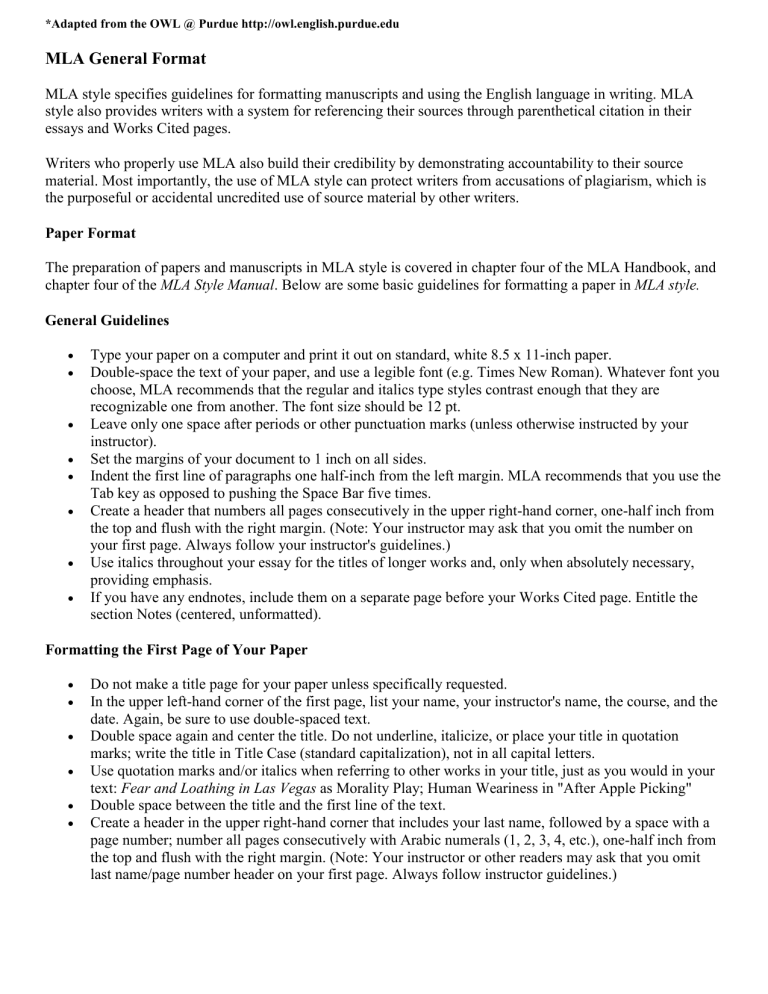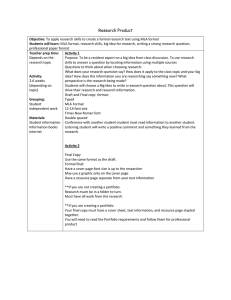MLA Formatting

*Adapted from the OWL @ Purdue http://owl.english.purdue.edu
MLA General Format
MLA style specifies guidelines for formatting manuscripts and using the English language in writing. MLA style also provides writers with a system for referencing their sources through parenthetical citation in their essays and Works Cited pages.
Writers who properly use MLA also build their credibility by demonstrating accountability to their source material. Most importantly, the use of MLA style can protect writers from accusations of plagiarism, which is the purposeful or accidental uncredited use of source material by other writers.
Paper Format
The preparation of papers and manuscripts in MLA style is covered in chapter four of the MLA Handbook, and chapter four of the MLA Style Manual . Below are some basic guidelines for formatting a paper in MLA style.
General Guidelines
•
•
Type your paper on a computer and print it out on standard, white 8.5 x 11-inch paper.
Double-space the text of your paper, and use a legible font (e.g. Times New Roman). Whatever font you choose, MLA recommends that the regular and italics type styles contrast enough that they are recognizable one from another. The font size should be 12 pt.
• Leave only one space after periods or other punctuation marks (unless otherwise instructed by your
• instructor).
• Set the margins of your document to 1 inch on all sides.
Indent the first line of paragraphs one half-inch from the left margin. MLA recommends that you use the
Tab key as opposed to pushing the Space Bar five times.
• Create a header that numbers all pages consecutively in the upper right-hand corner, one-half inch from the top and flush with the right margin. (Note: Your instructor may ask that you omit the number on
•
• your first page. Always follow your instructor's guidelines.)
Use italics throughout your essay for the titles of longer works and, only when absolutely necessary, providing emphasis.
If you have any endnotes, include them on a separate page before your Works Cited page. Entitle the section Notes (centered, unformatted).
Formatting the First Page of Your Paper
•
•
•
•
•
•
Do not make a title page for your paper unless specifically requested.
In the upper left-hand corner of the first page, list your name, your instructor's name, the course, and the date. Again, be sure to use double-spaced text.
Double space again and center the title. Do not underline, italicize, or place your title in quotation marks; write the title in Title Case (standard capitalization), not in all capital letters.
Use quotation marks and/or italics when referring to other works in your title, just as you would in your text: Fear and Loathing in Las Vegas as Morality Play; Human Weariness in "After Apple Picking"
Double space between the title and the first line of the text.
Create a header in the upper right-hand corner that includes your last name, followed by a space with a page number; number all pages consecutively with Arabic numerals (1, 2, 3, 4, etc.), one-half inch from the top and flush with the right margin. (Note: Your instructor or other readers may ask that you omit last name/page number header on your first page. Always follow instructor guidelines.)
Here is a sample of the first page of a paper in MLA style:


